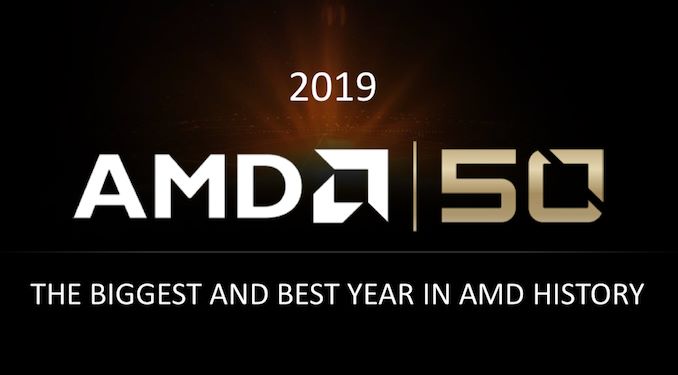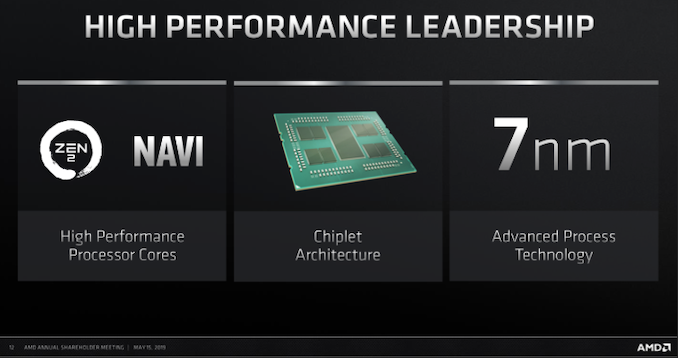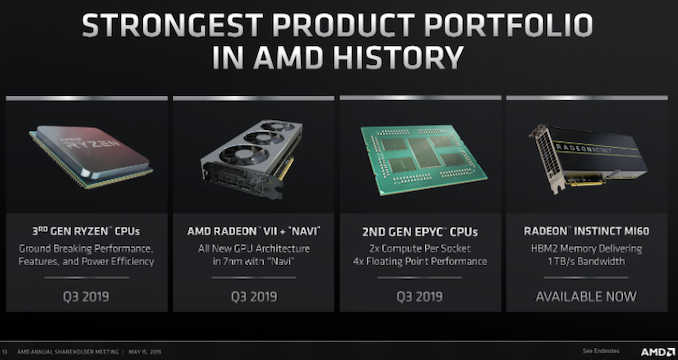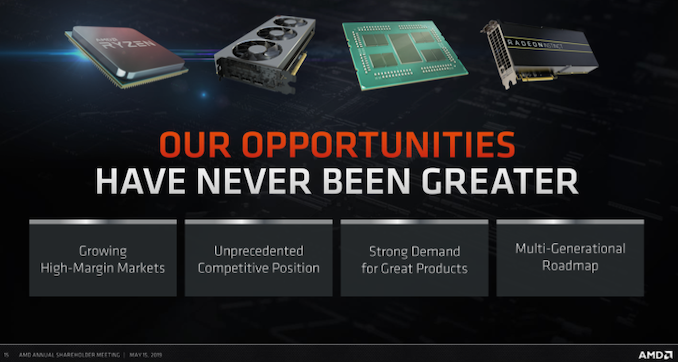AMD Reiterates 7nm Roadmap: Navi, Matisse, & Rome to Launch in Q3
by Anton Shilov on May 17, 2019 8:00 AM EST
AMD this week held its Annual Shareholder Meeting where it reiterated its current technology roadmap and once again confirmed that that its major products set to be released this year based on 7nm will be formally introduced in Q3. Previously the company implied on launch timeframes of its Navi GPU (at least one of them), Matisse CPUs, and Rome server CPUs, but never made a firm promise about the third quarter - this announcement is a commitment to delivering these products in Q3.
The High Level
On a high level, AMD believes that there are four technology pillars that will define its product roadmap in 2019 and forward. These pillars are: the Zen 2 CPU microarchitecture, its Navi GPU architecture, chiplet-based design architecture that enables it to mix and match features and technologies to build a right processor for a given platform, and IP for TSMC’s 7 nm manufacturing technology.
Since R&D processes take years, it was crucial for AMD to make the correct bets when its comes to microarchitecture and fabrication process. That said, this year’s product launches represent a culmination of multi-year efforts by the whole company, but considering that numerous architectural things may be re-used for years, it is important that they have been developed and implemented.
The Products
AMD’s 3rd Generation Ryzen processor, known as Matisse, promises a significant performance increase in general-purpose tasks from where AMD is today. It also adds several new features, such as PCIe 4.0 interface support. Launching this product “shortly in Q3” means that the company wants to make it available already during the important back-to-school season and well ahead of critically important holiday sales season.
Another vital product series for AMD is its next-gen lineup of GPUs based on its Navi architecture. At least one of these graphics processors will be launched in the third quarter. What is noteworthy is that Navi GPUs will coexist with AMD’s Radeon VII graphics cards, which indicates that the latter will continue to serve the enthusiast segment of the market. Furthermore, AMD’s 7nm Vega GPU in the form of the Radeon Instinct MI60 will continue to be offered for high-performance computing workloads.
Also due in Q3 are AMD’s 2nd Gen EPYC processors, known as Rome. These server CPUs are set to feature up to 64 cores powered by the company’s Zen 2 microarchitecture. It is worth keeping in mind that it takes server users some time to adopt new CPUs, and the launch of AMD’s 2nd Gen EPYC in Q3 does not necessarily mean that these processors will be used by a massive amount of designs straight away. Nonetheless, it is still important to release them rather sooner than later in a bid to ramp them up as soon as possible.
One product family worth mentioning is Threadripper. AMD's high-end desktop platform, currently available at 8-32 cores, is expected to be encroached on by the Ryzen 3000 series. AMD briefly held in its roadmaps that Threadripper based on Rome would be coming in 2019, however in its most recent disclosures, that commitment has no longer appeared and AMD has not commented on the matter. It could be that someone made a mistake putting it on the singular slide deck in which it appeared, or there's a level of inconsistency between AMD's presentation teams based on what they are presenting to whom. Hopefully AMD will clarify the matter in due course, and with Computex coming in two weeks, it would be a perfect time to do so.
Related Reading:
- AMD To Host “Next Horizon Gaming” Event & Product Unveil at E3 2019: June 10th, 3pm PT
- AMD: 7nm ‘Navi’ GPU & 'Rome' CPU to Launch in Q3
- AMD's 7nm CPUs & GPUs To Be Fabbed by TSMC, on Track for 2018 - 2019
- AMD Tech Day at CES: 2018 Roadmap Revealed, with Ryzen APUs, Zen+ on 12nm, Vega on 7nm
- AMD Unveils GPU Architecture Roadmap: After Polaris Comes Vega
Source: AMD













55 Comments
View All Comments
Ironchef3500 - Friday, May 17, 2019 - link
So they call Navi a GPU architecture, yet it is GCN based? How does that work? Would a new architecture not be based on itself?T1beriu - Friday, May 17, 2019 - link
Vega and Polaris were also GCN architectures. They're codenames and don't imply anything.Opencg - Friday, May 17, 2019 - link
To be fair even nvidias achitectures were designed to be gcn like. There is alot of complaining going around but deviating from the blueprint without significant gains elsewhere will lose out on all the gcn and gcn-like optimised games.mode_13h - Saturday, May 18, 2019 - link
There's "GCN-like" (by which I guess you mean SIMD + SMT) and there's GCN. The former is just an architectural approach (and I wouldn't really characterize Nvidia's architectures that way), while the latter includes a specific ISA and toolchain support (including in LLVM and GCC). The distinction has meaningful and very practical implications.Based on commits to the opensource Linux driver stack, I think we already know that Navi won't break continuity with GCN.
https://www.phoronix.com/scan.php?page=news_item&a...
However, I've seen some hints that post-Navi will be a departure from current GCN, but no firm confirmation.
From https://wccftech.com/amd-navi-radeon-rx-gpu-rumors... :
"Navi is meant to be the last GCN based GPU design by AMD"
We'll see...
Korguz - Saturday, May 18, 2019 - link
mode_13hbut can wccftech be trusted as reliable ?? seems from a few posts on here in other threads/articles that that site is a rumor site... IMO.. better to just wait and see how Navi performs..
Opencg - Sunday, May 19, 2019 - link
to give you an exapmle since you clearly cant come up with one on your own:with gcn shaders are grouped 64 per cu. games are optimised to dispatch work in a way that fills groups of 64 shaders with work more often. that way the shaders dont sit idle while they wait for either the cu to que up different work or for the other shaders to free up resources.
With pascal nvidia similarly grouped shaders into groups of 64. vs on maxwell it was 128 and more on earlier generations.
some games that switch between compute based effects and the graphics pipeline had a much higher penalty before pascal. making pascal more gcn like helped nvidia.
mode_13h - Tuesday, May 21, 2019 - link
So, just the SIMD-width is enough to qualify it as GCN-like? That's a silly thing to say!tipoo - Friday, May 17, 2019 - link
Navi is the code name for the evolution of the architecture.I.e every Skylake derivative.
zmatt - Friday, May 17, 2019 - link
There is more than one "architecture" when talking about a chip. First you have the ISA like x86 or ARM which defines how the instruction set works. Then you have the actual chip architecture, commonly known as microarch or uarch, which defines the chip itself. ISA's are pretty clear cut things but the microarch can be pretty loosely defined.If we use Intel as an example they generally organize architectures on three lines, the ISA which is x86, the family architecture which is currently just known as Core and the microarch of the specific cpu generation ie: Haswell, Skylake, Icelake etc.
GCN is interesting because AMD uses the term to define both the ISA and the family so you can think of it as akin to x86 + Core. But it does not define the microarch so Navi, Polaris and Vega are all different. They work similarly but that's like saying an Ivy Bridge Core i3 works similarly to a Coffee Lake i9. It doesn't mean much in terms or real world performance.
cerberusss - Friday, May 17, 2019 - link
Fun fact: "Navi" is the informal name for Gamma Cassiopeiae, a star that's 550 lightyears from the Sun. For some reason, I remember that it's actually the name "Ivan", spelled backwards. But I have no idea if this is true, or who this Ivan is :(